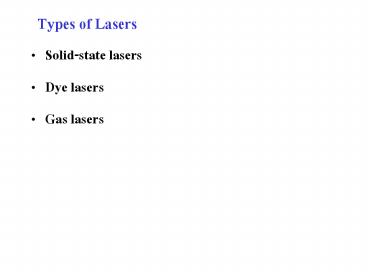Types of Lasers - PowerPoint PPT Presentation
1 / 24
Title:
Types of Lasers
Description:
???????????? 1960 ??? Ted Maiman ?????????????????? ??????????????????????? ???? ... Energy levels of chromium ions in ruby. Rapid non-radiative transitions ... – PowerPoint PPT presentation
Number of Views:2185
Avg rating:3.0/5.0
Title: Types of Lasers
1
Types of Lasers
- Solid-state lasers
- Dye lasers
- Gas lasers
2
The Ruby Laser
???????????? 1960 ??? Ted Maiman
?????????????????? ???????????????????????
??????????? Al2O3 ??? ???????????????? Al3
????????????????????? Cr3 ??????????,
??????????????????????????????????????????????
3
Nd3YAG Laser
Nd3- doped YAG Nd NeodymiumYAG Y3Al5O12
Yttrium Aluminium Garnet
4
Ti3sapphire Laser
Titanium-doped sapphire
5
Semiconductor Diode Lasers
6
Gas Lasers
7
The Helium-Neon Laser
He Ne 51
8
Carbon Dioxide Laser
The CO2 laser operates analogously. N2 is
pumped, transferring the energy to CO2.
9
The Helium Cadmium Laser
The population inversion scheme in HeCd is
similar to that in HeNes except that the active
medium is Cd ions. The laser transitions occur
in the blue and the ultraviolet at 442 nm, 354 nm
and 325 nm. The UV lines are useful for
applications that require short wavelength
lasers, such as high precision printing on
photosensitive materials. Examples include
lithography of electronic circuitry and
making master copies of compact disks.
10
The Argon Ion Laser
Argon lines Wavelength Relative Power
Absolute Power 454.6 nm .03 .8 W 457.9 nm
.06 1.5 W 465.8 nm .03 .8 W 472.7 nm .05
1.3 W 476.5 nm .12 3.0 W 488.0 nm .32
8.0 W 496.5 nm .12 3.0 W 501.7 nm .07
1.8 W 514.5 nm .40 10.0 W 528.7 nm .07
1.8 W
11
The Krypton Ion Laser
Krypton lines Wavelength Power 406.7 nm .9 W
413.1 nm 1.8 W 415.4 nm .28 W 468.0 nm .5
W 476.2 nm .4 W 482.5 nm .4 W 520.8 nm .7 W
530.9 nm 1.5 W 568.2 nm 1.1 W 647.1 nm 3.5
W 676.4 nm 1.2 W
12
Dye lasers
Dye lasers are an ideal four-level system, and a
given dye will lase over a range of 100 nm.
13
Dyes cover the visible, near-IR, and near-UV
ranges.
14
Titanium Sapphire (TiSapphire)
TiSapphire lases from 700 nm to 1000 nm.
15
Diode Lasers
16
Some everyday applications of diode lasers
A CD burner
Laser Printer
17
Laser Safety Classifications
- Class I - These lasers are not hazardous.
- Class IA - A special designation that applies
only to lasers that are "not intended for
viewing," such as a supermarket laser scanner.
The upper power limit of Class IA is 4 mW. - Class II - Low-power visible lasers that emit
above Class I levels but at a radiant power not
above 1 mW. The concept is that the human
aversion reaction to bright light will protect a
person. - Class IIIA - Intermediate-power lasers (cw 1-5
mW), which are hazardous only for intrabeam
viewing. Most pen-like pointing lasers are in
this class. - Class IIIB - Moderate-power lasers ( tens of
mW). - Class IV - High-power lasers (cw 500 mW, pulsed
10 J/cm2 or the diffuse reflection limit), which
are hazardous to view under any condition
(directly or diffusely scattered), and are a
potential fire hazard and a skin hazard.
Significant controls are required of Class IV
laser facilities.
18
(No Transcript)
19
He-Ne Laser
20
(No Transcript)
21
Laser Diode
- F.B. ???? pn junction ?????????? e ??? hole ??
recombine ???? ??? - ????? 2 ?????????? L ????????????????????????-??
???? Fabry-Perot ??? 2 ??????????????????????????
??????????????? ????????????????? resonance
modes ????????????????????????????????
22
(No Transcript)
23
(No Transcript)
24
(No Transcript)































